The Entomopathogenic Nematodes H. bacteriophora and S. carpocapsae Inhibit the Activation of proPO System of the Nipa Palm Hispid Octodonta nipae (Coleoptera: Chrysomelidae)
Abstract
1. Introduction
2. Materials and Methods
2.1. Experimental Samples
2.2. Reagents
2.3. Virulence of Entomopathogenic Nematodes on O. nipae Larvae
2.4. Expression of Four Selected Prophenoloxidase Activation Genes in O. nipae Post-Nematodes Infections
2.5. Influence of Nematodes Isolated Cuticle on the Expression Analysis of PPO Gene
2.6. Influence of Dexamethasone (DEX) and Arachidonic Acid (AA) on PO Activity in O. nipae
2.7. Combine Effects of Dexamethasone (DEX), Arachidonic Acid (AA), and Nematodes Treatments on the Expression Level of PPO Gene
2.8. Statistical Analyses
3. Results
3.1. Survival of O. nipae Larvae Infected with H. bacteriophora and S. carpocapsae
3.2. S. carpocapsae and H. bacteriophora Infection Suppress the Activation of O. nipae PPO System
3.3. The Heat-Treated Cuticles Positively Expresses the PPO Gene in O. nipae
3.4. Addition of Arachidonic Acid Reverses the Inhibitions of Phenoloxidase Activity Caused by Dexamethasone
3.5. Treatment with DEX Suppresses the Expression of the PPO Gene in O. nipae
4. Discussion
5. Conclusions
Author Contributions
Funding
Institutional Review Board Statement
Informed Consent Statement
Acknowledgments
Conflicts of Interest
References
- Hou, Y.; Weng, Z. Temperature-dependent development and life table parameters of Octodonta nipae (Coleoptera: Chrysomelidae). Environ. Entomol. 2010, 39, 1676–1684. [Google Scholar] [CrossRef] [PubMed]
- Hou, Y.; Wu, Z.; Wang, C.; Xie, L. The Status and Harm of Invasive Insects in Fujian, China; Biological invasions: Problems and countermeasures; Science Press: Beijing, China, 2011; pp. 111–114. [Google Scholar]
- Vassiliou, V.A.; Kazantzis, E.; Melifronidou-Pantelidou, A. First report of the nipa palm hispid Octodonta nipae on queen palms in Cyprus. Phytoparasitica 2011, 39, 51–54. [Google Scholar] [CrossRef]
- Zhang, X.; Tang, B.; Hou, Y. A rapid diagnostic technique to discriminate between two pests of palms, Brontispa longissima and Octodonta nipae (Coleoptera: Chrysomelidae), for quarantine applications. J. Econ. Entomol. 2015, 108, 95–99. [Google Scholar] [CrossRef]
- Li, J.; Zhang, X.; Hou, Y.; Tang, B. Effects of multiple mating on the fecundity of an invasive pest (Octodonta nipae): The existence of an intermediate optimal female mating rate. Physiol. Entomol. 2014, 39, 348–354. [Google Scholar] [CrossRef]
- Li, J.-L.; Tang, B.-Z.; Hou, Y.-M.; Xie, Y.-X. Molecular cloning and expression of the vitellogenin gene and its correlation with ovarian development in an invasive pest Octodonta nipae on two host plants. Bull. Entomol. Res. 2016, 106, 642–650. [Google Scholar] [CrossRef] [PubMed]
- Chen, Z.; Chen, J.; Zhang, X.; Hou, Y.; Wang, G. Development of microsatellite markers for the nipa palm hispid beetle, Octodonta nipae (Maulik). Can. J. Infect. Dis. Med. Microbiol. 2018, 2018, 9139306. [Google Scholar] [CrossRef]
- Peng, L.; Chen, L.; Li, J.; Hou, Y.; Chen, Y. Mate recognition and antennal morphology of Octodonta nipae (Coleoptera: Chrysomelidae) adults. J. Asia-Pac. Entomol. 2018, 21, 268–278. [Google Scholar] [CrossRef]
- Peng, L.-f.; Li, J.-l.; Hou, Y.-m.; Zhang, X. Descriptions of immature stages of Octodonta nipae (Maulik) (Coleoptera, Chrysomelidae, Cassidinae, Cryptonychini). ZooKeys 2018, 764, 91–109. [Google Scholar] [CrossRef]
- Hou, Y.; Miao, Y.; Zhang, Z. Leaf consumption capacity and damage projection of Octodonta nipae (Coleoptera: Chrysomelidae) on three palm species. Ann. Entomol. Soc. Am. 2014, 107, 1010–1017. [Google Scholar] [CrossRef]
- Hou, Y.; Miao, Y.; Zhang, Z. Study on life parameters of the invasive species Octodonta nipae (Coleoptera: Chrysomelidae) on different palm species, under laboratory conditions. J. Econ. Entomol. 2014, 107, 1486–1495. [Google Scholar] [CrossRef]
- Hua, R.; Hou, Y.; Shi, Z. Changes in the contents of physiologically active substances in Octodonta nipae (Coleoptera: Chrysomelidae) after low temperature acclimation. Acta Entomol. Sin. 2014, 57, 265–273. [Google Scholar]
- Feng, S.; Hou, Y. Lipopoly saccharide-induced immune response of Octodonta nipae (Coleoptera: Chrysomelidae) adults in relation to their genders. Acta Entomol. Sin. 2015, 58, 28–37. [Google Scholar]
- Ali, H.; Muhammad, A.; Sanda Bala, N.; Hou, Y. The endosymbiotic Wolbachia and host COI gene enables to distinguish between two invasive palm pests; coconut leaf beetle, Brontispa longissima and hispid leaf beetle, Octodonta nipae. J. Econ. Entomol. 2018, 111, 2894–2902. [Google Scholar] [CrossRef]
- Ali, H.; Muhammad, A.; Islam, S.U.; Islam, W.; Hou, Y. A novel bacterial symbiont association in the hispid beetle, Octodonta nipae (Coleoptera: Chrysomelidae), their dynamics and phylogeny. Microb. Pathog. 2018, 118, 378–386. [Google Scholar] [CrossRef] [PubMed]
- Ali, H.; Muhammad, A.; Sanda, N.B.; Huang, Y.; Hou, Y. Pyrosequencing uncovers a shift in bacterial communities across life stages of Octodonta nipae (Coleoptera: Chrysomelidae). Front. Microbiol. 2019, 10, 466. [Google Scholar] [CrossRef] [PubMed]
- Sanda, N.; Wudil, B.; Hou, Y. Effect of Temperatures on the Pathogenicity of Entomopathogenic Nematodes (Steinernema carpocapsae and Heterorhabditis bacteriophora) for Biocontrol of Octodonta nipae (Maulik). Niger. J. Entomol. 2020, 36, 88–95. [Google Scholar] [CrossRef]
- Sanda, N.B.; Hou, B.; Muhammad, A.; Ali, H.; Hou, Y. Exploring the role of Relish on antimicrobial peptide expressions (AMPs) upon nematode-bacteria complex challenge in the Nipa Palm Hispid Beetle, Octodonta nipae Maulik (Coleoptera: Chrysomelidae). Front. Microbiol. 2019, 10, 2466. [Google Scholar] [CrossRef]
- Sanda, N.B.; Muhammad, A.; Ali, H.; Hou, Y. Entomopathogenic nematode Steinernema carpocapsae surpasses the cellular immune responses of the hispid beetle, Octodonta nipae (Coleoptera: Chrysomelidae). Microb. Pathog. 2018, 124, 337–345. [Google Scholar] [CrossRef]
- Tang, B.; Chen, J.; Hou, Y.; Meng, E. Transcriptome immune analysis of the invasive beetle Octodonta nipae (Maulik)(Coleoptera: Chrysomelidae) parasitized by Tetrastichus brontispae Ferrière (Hymenoptera: Eulophidae). PLoS ONE 2014, 9, e91482. [Google Scholar] [CrossRef]
- Tang, B.-Z.; Meng, E.; Zhang, H.-J.; Zhang, X.-M.; Asgari, S.; Lin, Y.-P.; Lin, Y.-Y.; Peng, Z.-Q.; Qiao, T.; Zhang, X.-F. Combination of label-free quantitative proteomics and transcriptomics reveals intraspecific venom variation between the two strains of Tetrastichus brontispae, a parasitoid of two invasive beetles. J. Proteom. 2019, 192, 37–53. [Google Scholar] [CrossRef]
- Tang, B.; Xu, L.; Hou, Y. Effects of rearing conditions on the parasitism of Tetrastichus brontispae on its pupal host Octodonta nipae. BioControl 2014, 59, 647–657. [Google Scholar] [CrossRef]
- Toubarro, D.; Avila, M.M.; Montiel, R.; Simões, N. A pathogenic nematode targets recognition proteins to avoid insect defenses. PLoS ONE 2013, 8, e75691. [Google Scholar] [CrossRef] [PubMed]
- Meng, E.; Li, J.; Tang, B.; Hu, Y.; Qiao, T.; Hou, Y.; Lin, Y.; Chen, Z. Alteration of the phagocytosis and antimicrobial defense of Octodonta nipae (Coleoptera: Chrysomelidae) pupae to Escherichia coli following parasitism by Tetrastichus brontispae (Hymenoptera: Eulophidae). Bull. Entomol. Res. 2019, 109, 248–256. [Google Scholar] [CrossRef] [PubMed]
- Meng, E.; Qiao, T.; Tang, B.; Hou, Y.; Yu, W.; Chen, Z. Effects of ovarian fluid, venom and egg surface characteristics of Tetrastichus brontispae (Hymenoptera: Eulophidae) on the immune response of Octodonta nipae (Coleoptera: Chrysomelidae). J. Insect Physiol. 2018, 109, 125–137. [Google Scholar] [CrossRef] [PubMed]
- Meng, E.; Tang, B.; Hou, Y.; Chen, X.; Chen, J.; Yu, X.-Q. Altered immune function of Octodonta nipae (Maulik) to its pupal endoparasitoid, Tetrastichus brontispae Ferrière. Comp. Biochem. Physiol. Part B Biochem. Mol. Biol. 2016, 198, 100–109. [Google Scholar] [CrossRef]
- Meng, E.; Tang, B.; Li, J.; Fu, L.; Hou, Y. The first complete genome sequence of an iflavirus from the endoparasitoid wasp Tetrastichus brontispae. Arch. Virol. 2021, 166, 2333–2335. [Google Scholar] [CrossRef]
- Meng, E.; Tang, B.; Sanchez-Garcia, F.J.; Qiao, T.; Fu, L.; Wang, Y.; Hou, Y.-M.; Wu, J.-L.; Chen, Z.-M. The first complete genome sequence of a novel Tetrastichus brontispae RNA virus-1 (TbRV-1). Viruses 2019, 11, 257. [Google Scholar] [CrossRef]
- Howard, F.; Moore, D.; Giblin-Davis, R.; Abad, R. Insects on Palms; CABI International: Wallingford, UK, 2001. [Google Scholar]
- Chen, Q.; Peng, Z.; Xu, C.; Tang, C.; Lu, B.; Jin, Q.; Wen, H.; Wan, F. Biological assessment of Tetrastichus brontispae, a pupal parasitoid of coconut leaf beetle Brontispa longissima. Biocontrol Sci. Technol. 2010, 20, 283–295. [Google Scholar] [CrossRef]
- Nguyen, H.; Oo, T.; Ichiki, R.; Takano, S.; Murata, M.; Takasu, K.; Konishi, K.; Tunkumthong, S.; Chomphookhiaw, N.; Nakamura, S. Parasitisation of Tetrastichus brontispae (Hymenoptera: Eulophidae), a biological control agent of the coconut hispine beetle Brontispa longissima (Coleoptera: Chrysomelidae). Biocontrol Sci. Technol. 2012, 22, 955–968. [Google Scholar] [CrossRef]
- Xu, L.; Lan, J.; Hou, Y.; Chen, Y.; Chen, Z.; Weng, Z. Molecular identification and pathogenicity assay on Metarhizium against Octodonta nipae (Coleoptera: Chrysomelidae). Chin. J. Appl. Entomol. 2011, 48, 922–927. [Google Scholar]
- Kaya, H.K.; Gaugler, R. Entomopathogenic nematodes. Annu. Rev. Entomol. 1993, 38, 181–206. [Google Scholar] [CrossRef]
- Abbott, W.S. A method of computing the effectiveness of an insecticide. J. Econ. Entomol. 1925, 18, 265–267. [Google Scholar] [CrossRef]
- Taşkesen, Y.E.; Yüksel, E.; Canhilal, R. Field Performance of Entomopathogenic Nematodes against the Larvae of Zabrus spp. Clairville, 1806 (Coleoptera: Carabidae). Uluslararası Tarım Ve Yaban Hayatı Bilimleri Derg. 2021, 7, 429–437. [Google Scholar]
- Öğretmen, A.; Yüksel, E.; Canhilal, R. Susceptibility of larvae of wireworms (Agriotes spp.) (Coleoptera: Elateridae) to some Turkish isolates of entomopathogenic nematodes under laboratory and field conditions. Biol. Control. 2020, 149, 104320. [Google Scholar] [CrossRef]
- Özdemir, E.; Inak, E.; Evlice, E.; Yüksel, E.; Delialioğlu, R.A.; Susurluk, I.A. Effects of insecticides and synergistic chemicals on the efficacy of the entomopathogenic nematode Steinernema feltiae (Rhabditida: Steinernematidae) against Leptinotarsa decemlineata (Coleoptera: Chrysomelidae). Crop Prot. 2021, 144, 105605. [Google Scholar] [CrossRef]
- Grewal, P.S.; Gaugler, R.; Kaya, H.K.; Wusaty, M. Infectivity of the entomopathogenic nematode Steinernema scapterisci (Nematoda: Steinernematidae). J. Invertebr. Pathol. 1993, 62, 22–28. [Google Scholar] [CrossRef]
- Arthurs, S.; Heinz, K.; Prasifka, J. An analysis of using entomopathogenic nematodes against above-ground pests. Bull. Entomol. Res. 2004, 94, 297–306. [Google Scholar] [CrossRef]
- Trdan, S.; Vidrih, M.; Andjus, L.; Laznik, Ž. Activity of four entomopathogenic nematode species against different developmental stages of Colorado potato beetle, Leptinotarsa decemlineata (Coleoptera, Chrysomelidae). Helminthologia 2009, 46, 14–20. [Google Scholar] [CrossRef]
- Trdan, S.; Vidrih, M.; Valic, N. Activity of four entomopathogenic nematode species against young adults of Sitophilus granarius (Coleoptera: Curculionidae) and Oryzaephilus surinamensis (Coleoptera: Silvanidae) under laboratory conditions. J. Plant Dis. Prot. 2006, 113, 168–173. [Google Scholar] [CrossRef]
- Hara, A.; Kaya, H.; Gaugler, R.; Lebeck, L.; Mello, C. Entomopathogenic nematodes for biological control of the leafminer, Liriomyza trifolii (Dipt.: Agromyzidae). Entomophaga 1993, 38, 359–369. [Google Scholar] [CrossRef]
- Binda-Rossetti, S.; Mastore, M.; Protasoni, M.; Brivio, M.F. Effects of an entomopathogen nematode on the immune response of the insect pest red palm weevil: Focus on the host antimicrobial response. J. Invertebr. Pathol. 2016, 133, 110–119. [Google Scholar] [CrossRef] [PubMed]
- Levine, E.; Oloumi-Sadeghi, H. Management of diabroticite rootworms in corn. Annu. Rev. Entomol. 1991, 36, 229–255. [Google Scholar] [CrossRef]
- Yan, X.; Han, R.; Moens, M.; Chen, S.; De Clercq, P. Field evaluation of entomopathogenic nematodes for biological control of striped flea beetle, Phyllotreta striolata (Coleoptera: Chrysomelidae). BioControl 2013, 58, 247–256. [Google Scholar] [CrossRef]
- Li, X.-Y.; Cowles, R.; Cowles, E.; Gaugler, R.; Cox-Foster, D. Relationship between the successful infection by entomopathogenic nematodes and the host immune response. Int. J. Parasitol. 2007, 37, 365–374. [Google Scholar] [CrossRef]
- Shi, M.; Chen, X.-Y.; Zhu, N.; Chen, X.-X. Molecular identification of two prophenoloxidase-activating proteases from the hemocytes of Plutella xylostella (Lepidoptera: Plutellidae) and their transcript abundance changes in response to microbial challenges. J. Insect Sci. 2014, 14, 179. [Google Scholar] [CrossRef][Green Version]
- Galko, M.J.; Krasnow, M.A.; Arias, A.M. Cellular and genetic analysis of wound healing in Drosophila larvae. PLoS Biol. 2004, 2, e239. [Google Scholar] [CrossRef]
- Cerenius, L.; Lee, B.L.; Söderhäll, K. The proPO-system: Pros and cons for its role in invertebrate immunity. Trends Immunol. 2008, 29, 263–271. [Google Scholar] [CrossRef]
- Kanost, M.; Gorman, M. Phenoloxidases in insect immunity. In Insect Immunology; Academic Press: Cambridge, MA, USA, 2008; Volume 10, p. B978-012373976. [Google Scholar]
- Zhang, H.; Tang, B.; Lin, Y.; Chen, Z.; Zhang, X.; Ji, T.; Zhang, X.; Hou, Y. Identification of three prophenoloxidase--activating factors (PPAFs) from an invasive beetle Octodonta nipae Maulik (Coleoptera: Chrysomelidae) and their roles in the prophenoloxidase activation. Arch. Insect Biochem. Physiol. 2017, 96, e21425. [Google Scholar] [CrossRef]
- Zhang, H.-J.; Lin, Y.-P.; Liu, M.; Liang, X.-Y.; Ji, Y.-N.; Tang, B.-Z.; Hou, Y.-M. Functional conservation and division of two single-carbohydrate-recognition domain C-type lectins from the nipa palm hispid beetle Octodonta nipae (Maulik). Dev. Comp. Immunol. 2019, 100, 103416. [Google Scholar] [CrossRef]
- Zhang, X.-M.; Zhang, H.-J.; Liu, M.; Liu, B.; Zhang, X.-F.; Ma, C.-J.; Fu, T.-T.; Hou, Y.-M.; Tang, B.-Z. Cloning and immunosuppressive properties of an acyl-activating enzyme from the venom apparatus of Tetrastichus brontispae (Hymenoptera: Eulophidae). Toxins 2019, 11, 672. [Google Scholar] [CrossRef]
- Zhang, H.-J.; Lin, Y.-P.; Li, H.-Y.; Wang, R.; Fu, L.; Jia, Q.-C.; Hou, Y.-M.; Tang, B.-Z. Variation in Parasitoid Virulence of Tetrastichus brontispae during the Targeting of Two Host Beetles. Int. J. Mol. Sci. 2021, 22, 3581. [Google Scholar] [CrossRef] [PubMed]
- Zang, X.; Maizels, R.M. Serine proteinase inhibitors from nematodes and the arms race between host and pathogen. Trends Biochem. Sci. 2001, 26, 191–197. [Google Scholar] [CrossRef]
- Yadav, S.; Daugherty, S.; Shetty, A.C.; Eleftherianos, I. RNAseq analysis of the Drosophila response to the entomopathogenic nematode Steinernema. G3 Genes Genomes Genet 2017, 7, 1955–1967. [Google Scholar] [CrossRef] [PubMed]
- Cooper, D.; Eleftherianos, I. Parasitic nematode immunomodulatory strategies: Recent advances and perspectives. Pathogens 2016, 5, 58. [Google Scholar] [CrossRef] [PubMed]
- Srikanth, K.; Park, J.; Stanley, D.W.; Kim, Y. Plasmatocyte-spreading peptide influences hemocyte behavior via eicosanoids. Arch. Insect Biochem. Physiol. 2011, 78, 145–160. [Google Scholar] [CrossRef] [PubMed]
- Yi, Y.; Wu, G.; Lv, J.; Li, M. Eicosanoids mediate Galleria mellonella immune response to hemocoel injection of entomopathogenic nematode cuticles. Parasitol. Res. 2016, 115, 597–608. [Google Scholar] [CrossRef]
- Balsinde, J.; Winstead, M.V.; Dennis, E.A. Phospholipase A2 regulation of arachidonic acid mobilization. FEBS Lett. 2002, 531, 2–6. [Google Scholar] [CrossRef]
- Sadekuzzaman, M.; Park, Y.; Lee, S.; Kim, K.; Jung, J.K.; Kim, Y. An entomopathogenic bacterium, Xenorhabdus hominickii ANU101, produces oxindole and suppresses host insect immune response by inhibiting eicosanoid biosynthesis. J. Invertebr. Pathol. 2017, 145, 13–22. [Google Scholar] [CrossRef]
- Kim, H.; Keum, S.; Hasan, A.; Kim, H.; Jung, Y.; Lee, D.; Kim, Y. Identification of an entomopathogenic bacterium, Xenorhabdus ehlersii KSY, from Steinernema longicaudum GNUS101 and its immunosuppressive activity against insect host by inhibiting eicosanoid biosynthesis. J. Invertebr. Pathol. 2018, 159, 6–17. [Google Scholar] [CrossRef]
- Eom, S.; Park, Y.; Kim, Y. Sequential immunosuppressive activities of bacterial secondary metabolites from the entomopahogenic bacterium Xenorhabdus nematophila. J. Microbiol. 2014, 52, 161–168. [Google Scholar] [CrossRef]
- Sadekuzzaman, M.; Gautam, N.; Kim, Y. A novel calcium-independent phospholipase A2 and its physiological roles in development and immunity of a lepidopteran insect, Spodoptera exigua. Dev. Comp. Immunol. 2017, 77, 210–220. [Google Scholar] [CrossRef] [PubMed]
- Park, J.-A.; Kim, Y. Phospholipase A2 inhibitors in bacterial culture broth enhance pathogenicity of a fungus Nomuraea rileyi. J. Microbiol. 2012, 50, 644–651. [Google Scholar] [CrossRef] [PubMed]
- Duvic, B.; Jouan, V.; Essa, N.; Girard, P.-A.; Pages, S.; Abi Khattar, Z.; Volkoff, N.-A.; Givaudan, A.; Destoumieux-Garzon, D.; Escoubas, J.-M. Cecropins as a marker of Spodoptera frugiperda immunosuppression during entomopathogenic bacterial challenge. J. Insect Physiol. 2012, 58, 881–888. [Google Scholar] [CrossRef]
- Ahmed, S.; Kim, Y. Differential immunosuppression by inhibiting PLA2 affects virulence of Xenorhabdus hominickii and Photorhabdus temperata temperata. J. Invertebr. Pathol. 2018, 157, 136–146. [Google Scholar] [CrossRef]
- Yan, X.; Liu, X.; Han, R.; Chen, S.; De Clercq, P.; Moens, M. Osmotic induction of anhydrobiosis in entomopathogenic nematodes of the genera Heterorhabditis and Steinernema. Biol. Control. 2010, 53, 325–330. [Google Scholar] [CrossRef]
- Kaya, H.K.; Aguillera, M.; Alumai, A.; Choo, H.Y.; De la Torre, M.; Fodor, A.; Ganguly, S.; Hazır, S.; Lakatos, T.; Pye, A. Status of entomopathogenic nematodes and their symbiotic bacteria from selected countries or regions of the world. Biol. Control. 2006, 38, 134–155. [Google Scholar] [CrossRef]
- White, G. A method for obtaining infective nematode larvae from cultures. Science 1927, 66, 302–303. [Google Scholar] [CrossRef]
- Koppenhöfer, A.M.; Brown, I.M.; Gaugler, R.; Grewal, P.S.; Kaya, H.K.; Klein, M.G. Synergism of entomopathogenic nematodes and imidacloprid against white grubs: Greenhouse and field evaluation. Biol. Control. 2000, 19, 245–251. [Google Scholar] [CrossRef]
- Ebrahimi, L.; Niknam, G.; Dunphy, G. Hemocyte responses of the Colorado potato beetle, Leptinotarsa decemlineata, and the greater wax moth, Galleria mellonella, to the entomopathogenic nematodes, Steinernema feltiae and Heterorhabditis bacteriophora. J. Insect Sci. 2011, 11, 75. [Google Scholar] [CrossRef]
- Memari, Z.; Karimi, J.; Kamali, S.; Goldansaz, S.H.; Hosseini, M. Are entomopathogenic nematodes effective biological control agents against the carob moth, Ectomyelois ceratoniae? J. Nematol. 2016, 48, 261. [Google Scholar] [CrossRef]
- Sharifi, S.; Karimi, J.; Hosseini, M.; Rezapanah, M. Efficacy of two entomopathogenic nematode species as potential biocontrol agents against the rosaceae longhorned beetle, Osphranteria coerulescens, under laboratory conditions. Nematology 2014, 16, 729–737. [Google Scholar] [CrossRef]
- Shapiro-Ilan, D.I.; Cottrell, T.E. Susceptibility of the lesser peachtree borer (Lepidoptera: Sesiidae) to entomopathogenic nematodes under laboratory conditions. Environ. Entomol. 2006, 35, 358–365. [Google Scholar] [CrossRef]
- Susurluk, I.A. Influence of temperature on the vertical movement of the entomopathogenic nematodes Steinernema feltiae (TUR-S3) and Heterorhabditis bacteriophora (TUR-H2), and infectivity of the moving nematodes. Nematology 2008, 10, 137–141. [Google Scholar] [CrossRef]
- Batalla-Carrera, L.; Morton, A.; García-del-Pino, F. Efficacy of entomopathogenic nematodes against the tomato leafminer Tuta absoluta in laboratory and greenhouse conditions. BioControl 2010, 55, 523–530. [Google Scholar] [CrossRef]
- Ashtari, M.; Karimi, J.; Rezapanah, M.R.; Hassani-Kakhki, M. Biocontrol of leopard moth, Zeuzera pyrina L. (Lep.: Cossidae) using entomopathogenic nematodes in Iran. IOBC/Wprs Bull. 2011, 66, 333–335. [Google Scholar]
- Yadav, A.K. Efficacy of indigenous entomopathogenic nematodes from Meghalaya, India against the larvae of taro leaf beetle, Aplosonyx chalybaeus (Hope). J. Parasit. Dis. 2012, 36, 149–154. [Google Scholar] [CrossRef][Green Version]
- Nagesh, M.; Kumar, N.; Shylesha, A.; Srinivasa, N.; Javeed, S.; Thippeswamy, R. Comparative virulence of strains of entomopathogenic nematodes for management of eggplant grey weevil, Myllocerus subfasciatus Guerin (Coleoptera: Curculionidae). Indian J. Exp. Biol. 2016, 54, 835–842. [Google Scholar]
- Jung, S.; Kim, Y. Synergistic effect of Xenorhabdus nematophila K1 and Bacillus thuringiensis subsp. aizawai against Spodoptera exigua (Lepidoptera: Noctuidae). Biol. Control. 2006, 39, 201–209. [Google Scholar] [CrossRef]
- Susurluk, I.A.; Kumral, N.A.; Peters, A.; Bilgili, U.; Açıkgöz, E. Pathogenicity, reproduction and foraging behaviours of some entomopathogenic nematodes on a new turf pest, Dorcadion pseudopreissi (Coleoptera: Cerambycidae). Biocontrol Sci. Technol. 2009, 19, 585–594. [Google Scholar] [CrossRef]
- Phan, K.; Tirry, L.; Moens, M. Pathogenic potential of six isolates of entomopathogenic nematodes (Rhabditida: Steinernematidae) from Vietnam. BioControl 2005, 50, 477–491. [Google Scholar] [CrossRef]
- Hedayat-allah, M.S.; Hussein, M.A.; Hafez, S.E.; Hussein, M.A.; Sayed, R.M. Ultrastructure changes in the haemocytes of Galleria mellonella larvae treated with gamma irradiated Steinernema carpocapsae BA2. J. Radiat. Res. Appl. Sci. 2014, 7, 74–79. [Google Scholar]
- Caroli, L.; Glazer, I.; Gaugler, R. Entomopathogenic nematode infectivity assay: Comparison of penetration rate into different hosts. Biocontrol Sci. Technol. 1996, 6, 227–234. [Google Scholar] [CrossRef]
- Brehélin, M.; Drif, L.; Boemare, N. Depression of defence reactions in insects by Steinernematidae and their associated bacteria. In Proceedings of the Proceedings and Abstracts, Vth International Colloquium on Invertebrate Pathology and Microbial Control, Adelaide, Australia, 20–24 August 1990; pp. 213–217. [Google Scholar]
- DUNPHY, G.B.; HURLBERT, R.E. Interaction of avirulent transpositional mutants of Xenorhabdus nematophilus ATCC 19061 (Enterobacteriaceae) with the antibacterial systems of non-immune Galleria mellonella (Insecta) larvae. J. Gen. Appl. Microbiol. 1995, 41, 409–427. [Google Scholar] [CrossRef][Green Version]
- Brooks, C.L.; Dunphy, G.B. Protein kinase A affects Galleria mellonella (Insecta: Lepidoptera) larval haemocyte non-self responses. Immunol. Cell Biol. 2005, 83, 150–159. [Google Scholar] [CrossRef]
- Stanley, D.; Miller, J.; Tunaz, H. Eicosanoid actions in insect immunity. J. Innate Immun. 2009, 1, 282–290. [Google Scholar] [CrossRef]
- Balasubramanian, N.; Toubarro, D.; Simoes, N. Biochemical study and in vitro insect immune suppression by a trypsin-like secreted protease from the nematode Steinernema carpocapsae. Parasite Immunol. 2010, 32, 165–175. [Google Scholar] [CrossRef]
- Brivio, M.F.; Pagani, M.; Restelli, S. Immune suppression of Galleria mellonella (Insecta, Lepidoptera) humoral defenses induced by Steinernema feltiae (Nematoda, Rhabditida): Involvement of the parasite cuticle. Exp. Parasitol. 2002, 101, 149–156. [Google Scholar] [CrossRef]
- Brivio, M.F.; Mastore, M.; Moro, M. The role of Steinernema feltiae body-surface lipids in host–parasite immunological interactions. Mol. Biochem. Parasitol. 2004, 135, 111–121. [Google Scholar] [CrossRef]
- Sheykhnejad, H.; Ghadamyari, M.; Ghasemi, V.; Jamali, S.; Karimi, J. Haemocytes immunity of rose sawfly, Arge ochropus (Hym.: Argidae) against entomopathogenic nematodes, Steinernema carpocapsae and Heterorhabditis bacteriophora. J. Asia-Pac. Entomol. 2014, 17, 879–883. [Google Scholar] [CrossRef]
- Brivio, M.F.; Moro, M.; Mastore, M. Down-regulation of antibacterial peptide synthesis in an insect model induced by the body-surface of an entomoparasite (Steinernema feltiae). Dev. Comp. Immunol. 2006, 30, 627–638. [Google Scholar] [CrossRef]
- Wang, Q.; Ke, L.; Xue, C.; Luo, W.; Chen, Q. Inhibitory Kinetics of p-Substituted Benzaldehydes on Polyphenol Oxidase from the Fifth Instar of Pieris Rapae L. Tsinghua Sci. Technol. 2007, 12, 400–404. [Google Scholar] [CrossRef]
- Ullah, I.; Khan, A.L.; Ali, L.; Khan, A.R.; Waqas, M.; Hussain, J.; Lee, I.-J.; Shin, J.-H. Benzaldehyde as an insecticidal, antimicrobial, and antioxidant compound produced by Photorhabdus temperata M1021. J. Microbiol. 2015, 53, 127–133. [Google Scholar] [CrossRef] [PubMed]
- Kwon, B.; Kim, Y. Benzylideneacetone, an immunosuppressant, enhances virulence of Bacillus thuringiensis against beet armyworm (Lepidoptera: Noctuidae). J. Econ. Entomol. 2008, 101, 36–41. [Google Scholar] [CrossRef]
- Kim, G.S.; Kim, Y. Up-regulation of circulating hemocyte population in response to bacterial challenge is mediated by octopamine and 5-hydroxytryptamine via Rac1 signal in Spodoptera exigua. J. Insect Physiol. 2010, 56, 559–566. [Google Scholar] [CrossRef] [PubMed]
- Seo, S.; Lee, S.; Hong, Y.; Kim, Y. Phospholipase A2 inhibitors synthesized by two entomopathogenic bacteria, Xenorhabdus nematophila and Photorhabdus temperata subsp. temperata. Appl. Environ. Microbiol. 2012, 78, 3816–3823. [Google Scholar] [CrossRef] [PubMed]
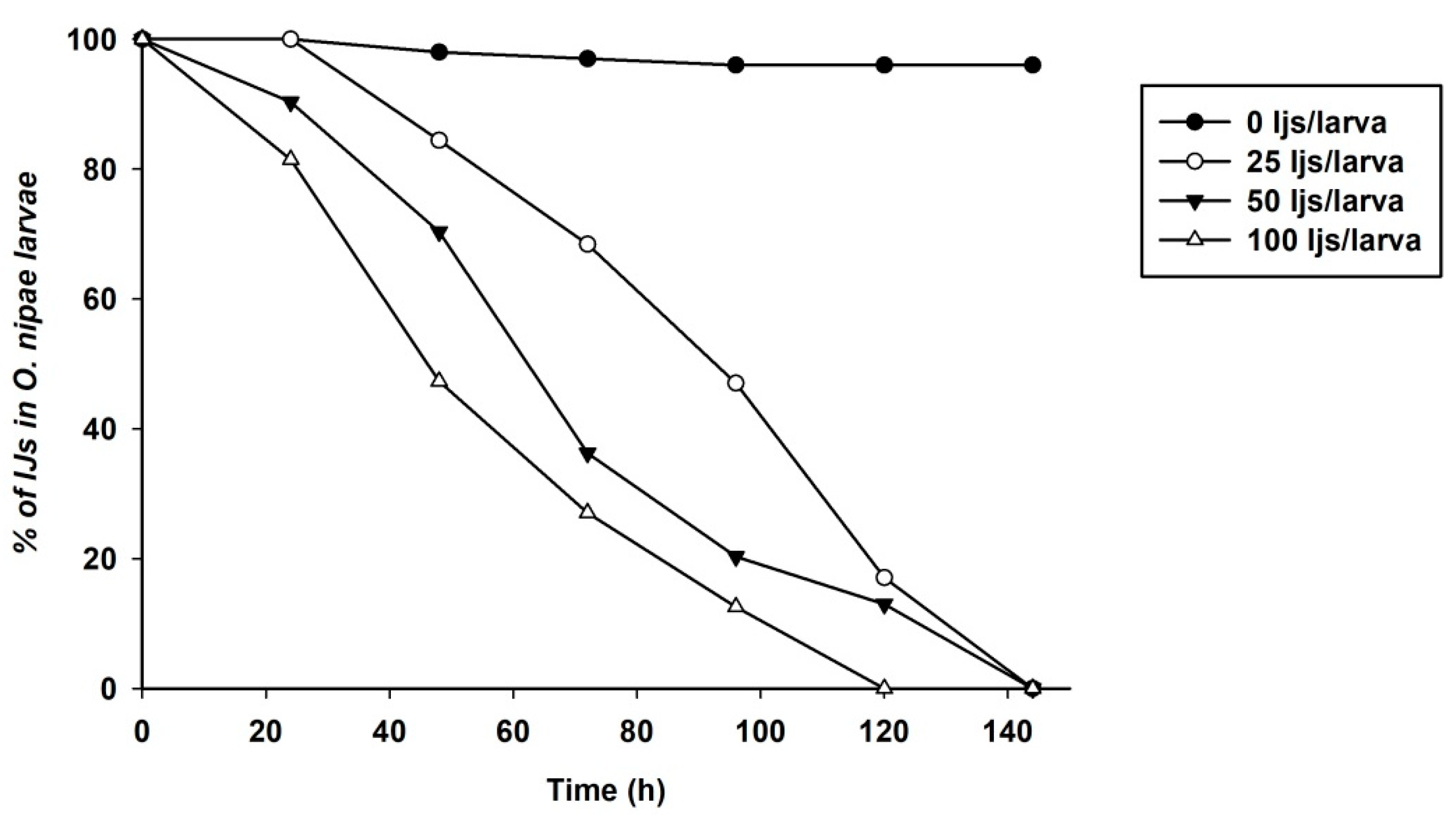
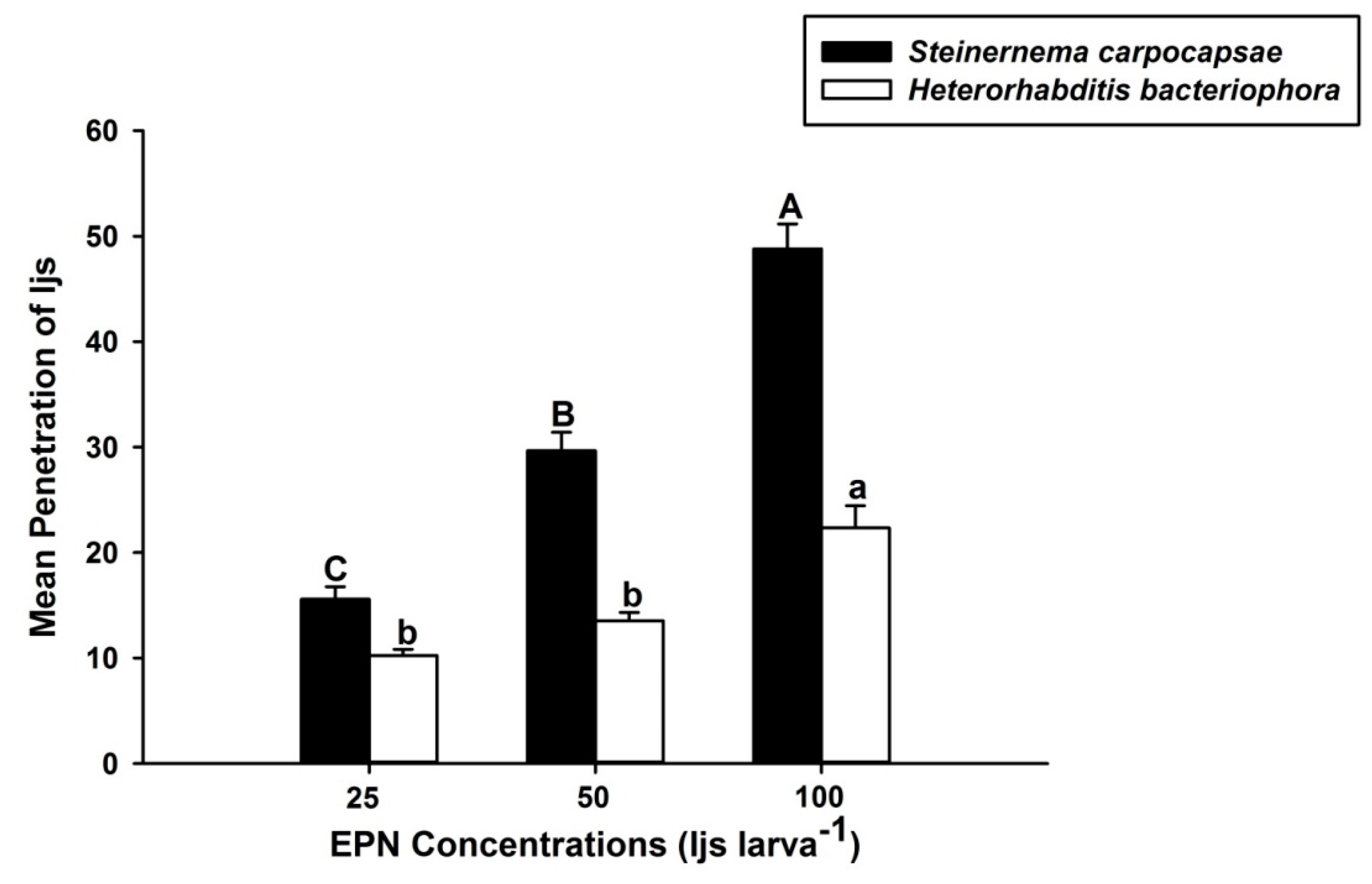


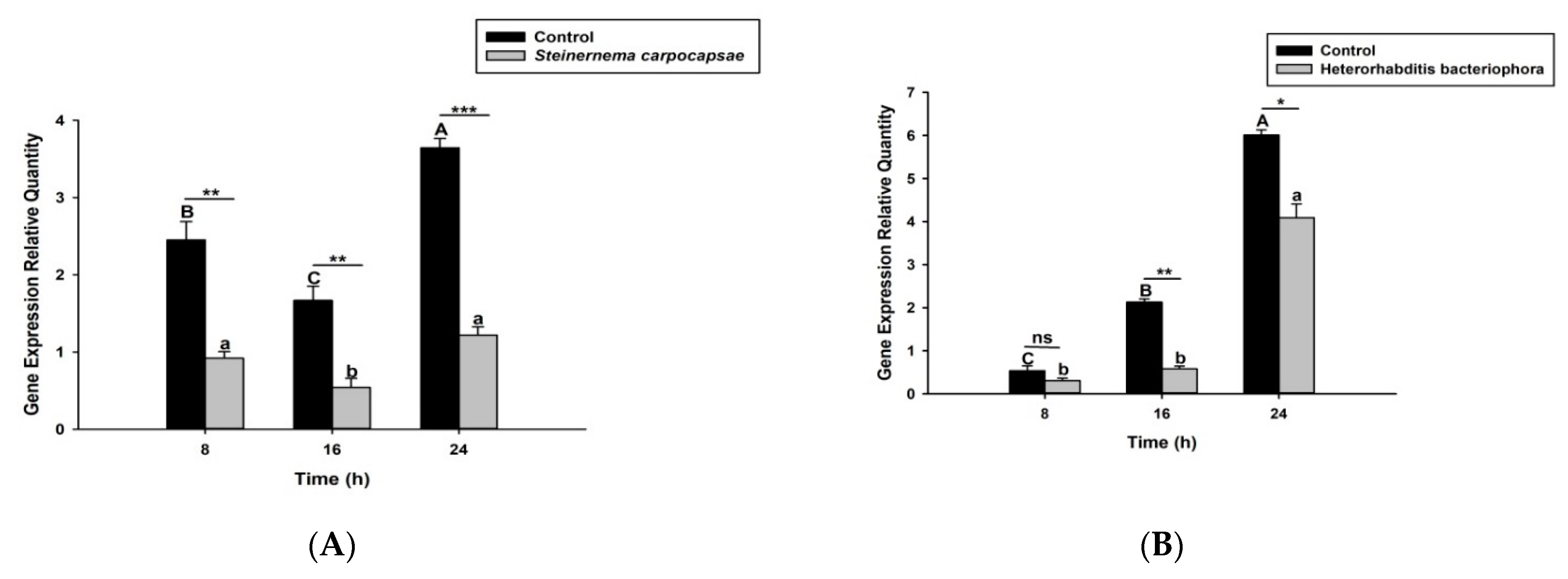
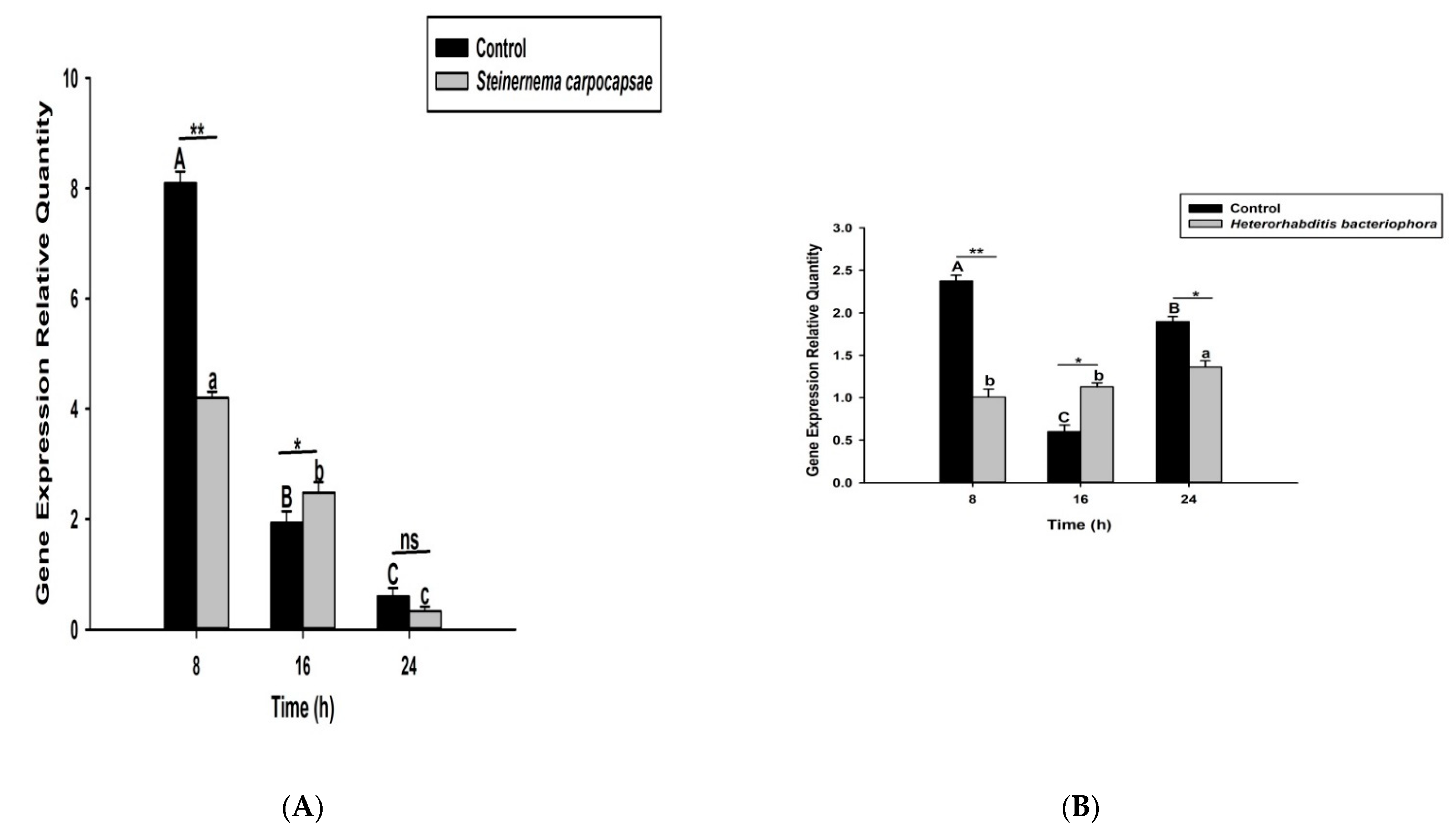

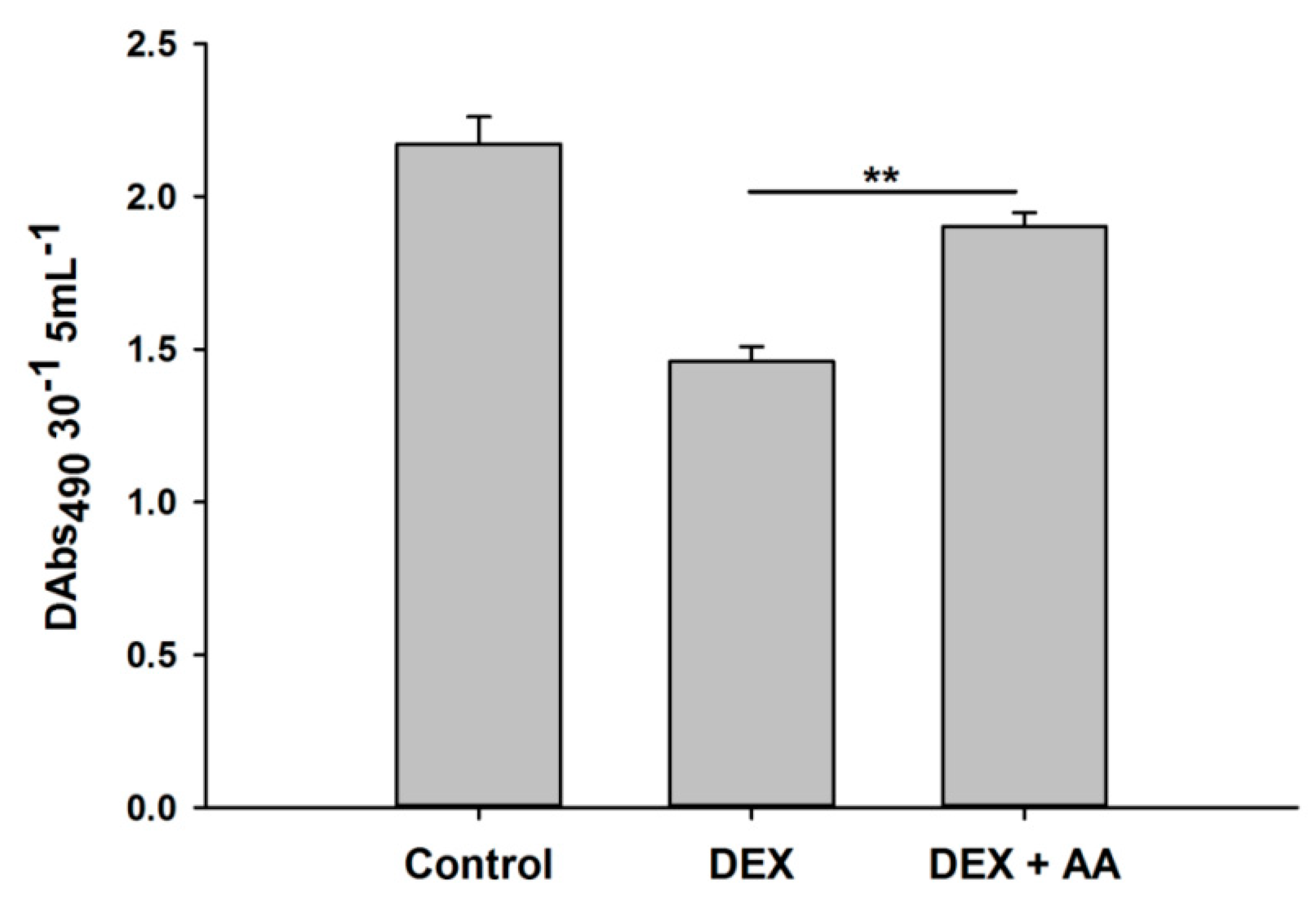
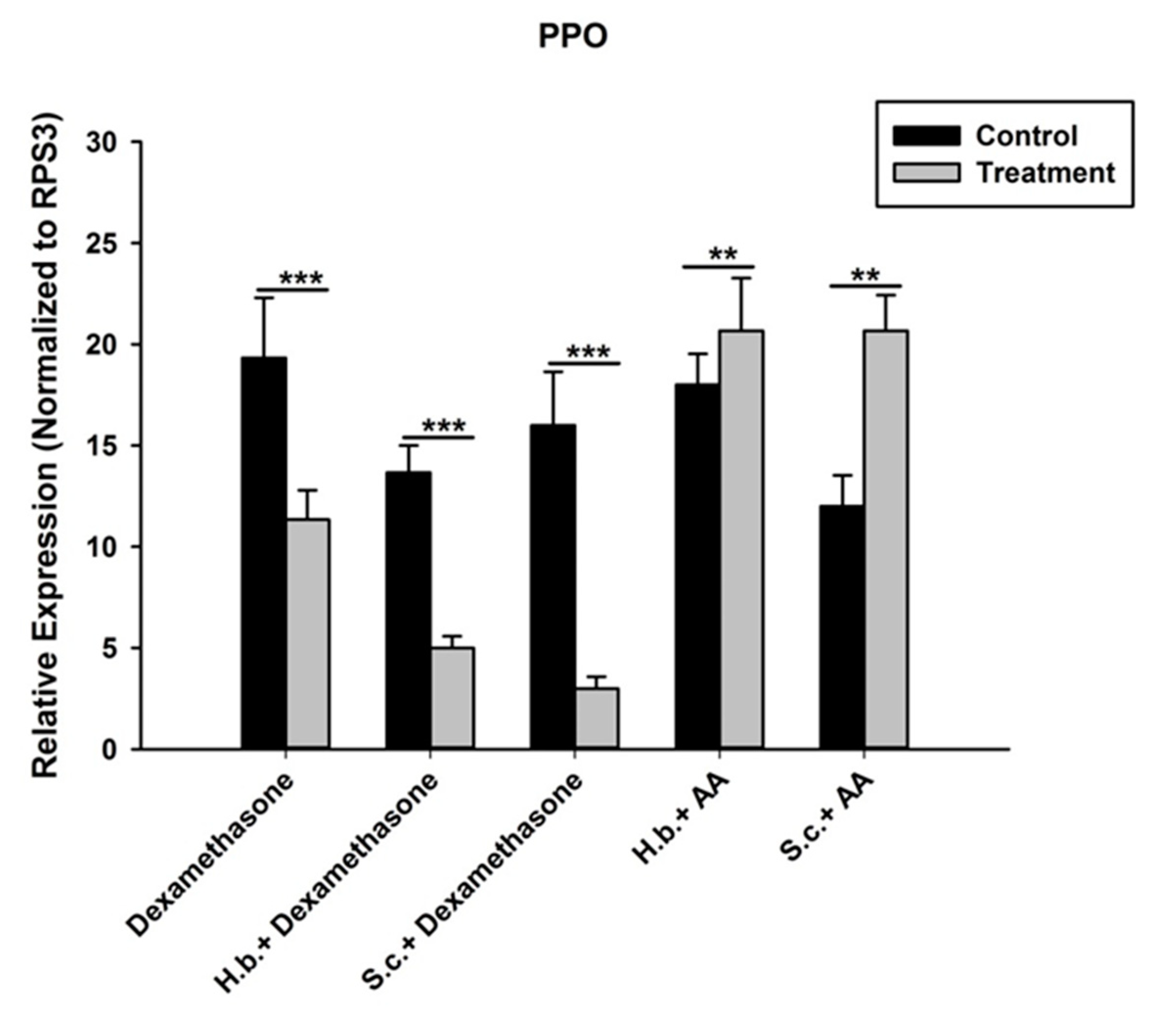
| Gene Name | Forward Primer (5′→3′) | Reverse Primer (5′→3′) |
|---|---|---|
| qSPP56 | CGGTTGGTGGAAAGTGTCAG | CCCTCGTTGTCCAGCTTCTA |
| qSPI28 | TCGCCTTAGTGATAGCGTGT | ACAGGGCTAGGGAAAACTCC |
| qPPAF1 | GATCACCGGCGACAAAGAAA | CAGCTTGTTGGGATTGCCTT |
| qPPO | GTATCTTGTCACCCAATAGAGC | AAACGATTCAAGATGCCTGT |
| q-RPS3-F | GACGGTGTCTTCAAAGCTGA | ATTTCTGTACGTGTCGGGGT |
Publisher’s Note: MDPI stays neutral with regard to jurisdictional claims in published maps and institutional affiliations. |
© 2022 by the authors. Licensee MDPI, Basel, Switzerland. This article is an open access article distributed under the terms and conditions of the Creative Commons Attribution (CC BY) license (https://creativecommons.org/licenses/by/4.0/).
Share and Cite
Sanda, N.B.; Hou, B.; Hou, Y. The Entomopathogenic Nematodes H. bacteriophora and S. carpocapsae Inhibit the Activation of proPO System of the Nipa Palm Hispid Octodonta nipae (Coleoptera: Chrysomelidae). Life 2022, 12, 1019. https://doi.org/10.3390/life12071019
Sanda NB, Hou B, Hou Y. The Entomopathogenic Nematodes H. bacteriophora and S. carpocapsae Inhibit the Activation of proPO System of the Nipa Palm Hispid Octodonta nipae (Coleoptera: Chrysomelidae). Life. 2022; 12(7):1019. https://doi.org/10.3390/life12071019
Chicago/Turabian StyleSanda, Nafiu Bala, Bofeng Hou, and Youming Hou. 2022. "The Entomopathogenic Nematodes H. bacteriophora and S. carpocapsae Inhibit the Activation of proPO System of the Nipa Palm Hispid Octodonta nipae (Coleoptera: Chrysomelidae)" Life 12, no. 7: 1019. https://doi.org/10.3390/life12071019
APA StyleSanda, N. B., Hou, B., & Hou, Y. (2022). The Entomopathogenic Nematodes H. bacteriophora and S. carpocapsae Inhibit the Activation of proPO System of the Nipa Palm Hispid Octodonta nipae (Coleoptera: Chrysomelidae). Life, 12(7), 1019. https://doi.org/10.3390/life12071019






